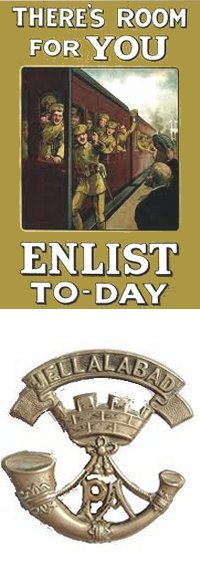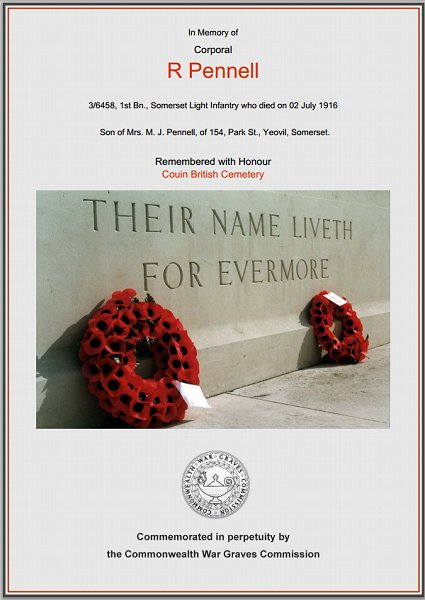yeovil at War
reginald pennell
Died from wounds in the Battle of the Somme
Reginald Pennell was born in Yeovil in 1894, the son of glover's labourer Henry Pennell, known as Harry, (1861-1917) and his wife Jane née Cousins (b 1864). In the 1901 census Harry and Jane were listed at 156 Park Street with their family; Charlie born 1887, Bertie born 1889 (and not the Bertie Pennell killed in 1916), Reginald born 1894, Beatrice born 1896 and William born 1898. In the 1911 census the family were living at 3 Park Row, Park Street. Harry gave his occupation as a general labourer and Reginald gave his as an Iron Moulder Apprentice at an Oil Engine Factory - in other words, he worked at the Nautilus Works in Reckleford.
 At
the outbreak of
the First World
War Reginald
enlisted at
Taunton and
joined
the regular 1st
Battalion of the
Somerset Light
Infantry as Private
Reginald Pennell (Service No
6458).
At
the outbreak of
the First World
War Reginald
enlisted at
Taunton and
joined
the regular 1st
Battalion of the
Somerset Light
Infantry as Private
Reginald Pennell (Service No
6458).
After his basic training Reginald soon joined his unit on the Western Front in early 1915, when the 1st Battalion fought in the Second Battle of Ypres.
The Second Battle of Ypres, 22 April-25 May 1915, was a rare German offensive on the Western Front during 1915. It was launched with two aims in mind. The first was to distract attention from the movement of German troops to the eastern front in preparation for the campaign that would lead to the victory of Gorlice-Tarnow. The second was to assess the impact of poisoned gas on the western front. Gas had already been used on the eastern front, at Bolimov (3 January 1915), but the tear gas used there had frozen in the extreme cold. At Ypres the Germans used the first lethal gas of the war, chlorine. The gas was to be released from 6,000 cylinders and would rely on the wind to blow it over the allied trenches. This method of delivery controlled the timing of the attack – the prevailing winds on the western front came from the west, so the Germans had to wait for a suitable wind from the east to launch their attack. The line around Ypres was held by French, Canadian and British troops. The attack on 22 April hit the French lines worst and, not surprisingly, the line broke under the impact of this deadly new weapon. The gas created a gap 8,000 yards long in the Allied lines north of Ypres. The success of their gas had surprised the Germans who didn’t have the reserves to quickly exploit the unexpected breakthrough, allowing enough time to plug the gap with newly arrived Canadian troops. During the battle the British, French and Canadians suffered 60,000 casualties, the Germans only 35,000.
Reginald was promoted to Corporal and in 1916 the 1st Battalion moved south and were in action during the Battles of the Somme.
The Battle for the Somme has a unique place in British military history. Haig was in the middle of preparations for a British offensive but came under strong pressure to mount an attack due the French commitment to the Battle for Verdun, a city which held an important place in the nation's psyche and that the Germans had attacked in February 1916. Any Allied offensive would therefore have to be carried mainly by the British. Haig was therefore forced to undertake an offensive near to where the British and French lines met, near Bray-sur-Somme in Picardy, although he would have preferred to attack further north and to have had longer with which to prepare his new army. The battlefield was bisected by both the Albert – Bapaume Road and the River Somme, and was a series of gentle chalk ridge lines into which the Germans had dug a series of well-prepared fortifications. Haig's plan called for Rawlinson’s Fourth Army to achieve a breakthrough in the centre after which Gough’s Reserve Army (later renamed the Fifth Army) would exploit, roll up the German defences and capture Bapaume. Allenby's Third Army would undertake a diversionary attack on Gommecourt, which lay to the north. The massive preparatory bombardment, meant to destroy the German defences started on 24 June 1916 at 06.00. Over 1.7 million shells were fired but a high proportion, some 30 percent, failed to explode as the Ministry of Munitions had abandoned any semblance of quality control in order to be able to produce the quantities needed in time. Tunnelling companies dug hollowed out chambers underneath key German strongpoints and filled them with explosives. The shelling had started on 'U' Day and was meant to go on until 'Z' Day, which was 29 June 1916 but heavy rains caused the approach roads, trenches and crater ridden No-Man's land too muddy and so the assault was postponed until 1 July. Just after dawn on 1 July, the first British wave clambered out of their trenches and started to make their way towards the German frontline. As they did, seventeen enormous mines were detonated and the barrage moved forward. The infantry followed behind and although there were local gains on the first day, generally things looked bleak. The British suffered 57,470 casualties (19,240 killed and 2,152 missing) which was an unprecedented experience for the British Army. Reginald Pennell died from his wounds the following day, 2 July 1916. He was aged just 22.
On 14 July 1916 the Western Gazette Reported "News has been received that Corporal R Pennell, of the Somerset LI, son of Mrs R Pennell, of Park Street, Yeovil, has died of wounds received in action. Corpl. Pennell joined the Army soon after the outbreak of war, and having had his training, went on active service where he quickly gained promotion."
Reginald Pennell was interred in Couin British Cemetery, Pas de Calais, France, Grave II.A.3, and his name is recorded on the War Memorial in the Borough.
gallery

The Commonwealth War Graves Commission certificate in memory of Reginald Pennell.